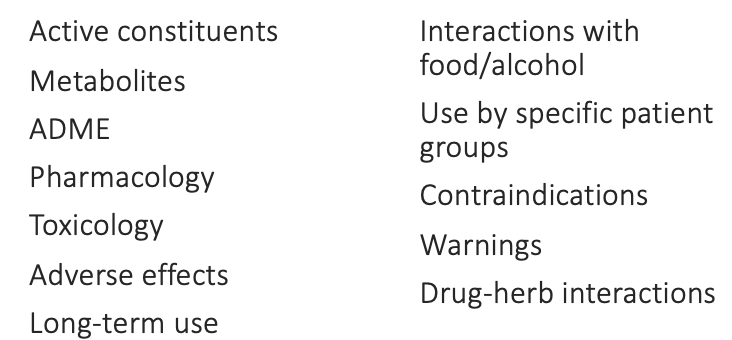Herbal and natural medicines
1/21
There's no tags or description
Looks like no tags are added yet.
Name | Mastery | Learn | Test | Matching | Spaced |
|---|
No study sessions yet.
22 Terms
what are herbal medicinal products (HMPs)
contains only herbs/plant material as active ingredients
complex mixtures derived from plant material
their active constituents are widely unknown
have interactions between the chemical compounds in herbal medicines
what are the interactions between chemical compounds in herbal medicines
may enhance activity and reduce likelihood of adverse effects
interactions are additive/synergistic (as all compounds interact with each other to produce a greater effect than singular)
different to natural products as, although they are plant derived, they are single chemical compound, herbal medicines contain a number of different chemical compounds
how do patients and the public see herbal medicines as
complementary or alternative
complementary → take a herbal product alongside prescribed medicine
alternative → taken as a complete alternative to prescribed medication
what types of drugs can we derive from plants
herbal drugs → derived from specific parts of a a medicinal plant (HMPs, herbal remedies, phytomedicines)
natural products/compounds → isolated from nature (pure chemical entities used in the form of licensed medicines, now produced synthetically and referred as nature identical)
nutraceuticals (functional foods) → foods with additional health benefits but only in the context of prophylactic activity, have preventive effects
give examples of herbal drugs we can derive from plants
senna pods for laxatives and senna leaves for cognitive deficiency e.g. alhzheimer’s
st john’s wort for low mood
german chamomile flowerheads for mild GI complaints and inflammation
give examples natural products/compounds we can derive from plants
morphine
digoxin
paclitaxel
quinine
caffeine
give examples of nutraceuiticals (functional foods) we can derive from plants
garlic → anti platelet to thin blood and reduce blood clots
ginger → for nausea and vomiting
turmeric → anti-inflammatory agent
carrots → vitamin A for function of retina
cocoa → antioxidants for harmful free radical in body
red wine → full of antioxidants for free radicals in body
what specific plant organs of a plant species are HMPs derived from
aerial parts/herb (herba) → whole plant used
leaf (folia)
flower (flos)
fruit (fructus)
bark (cortex)
root (radix)
rhizome (rhizoma) → underground stem, not root e.g. ginger
bulb (bulbus)
seed (semen)
what do you need to know about a plant if you make a plant derived drug
the species from which its obtained
the name of plant
the plant part used to produce the dried product
what does it mean if a product is considered to be adultered
if product contains the wrong parts e.g. if the product is supposed to contain leaf material, but has aerial material as well
what are the use of herbal medicinal products (HMPs)
high level of expenditure: UK market rising
mostly purchased OTC: general well-being/prevention and treatment of common ailments
serious chronic illnesses; cancer, HIV/AIDS, MS, asthma
elderly, pregnant/lactating women, parents administer to children
what are the three routes that herbal medicinal products are regulated
unlicensed herbal remedies
registered traditional herbal medicines
licensed herbal medicines
what are unlicensed herbal medicines
don’t have to meet standards of safety and quality
not required to have necessary information for a patient to use them e.g. safety warnings, contraindications etc
normally sold on internet
what are registered traditional herbal medicines
the Traditional Herbal Medicines Registration Scheme (THMRS)
need to meet specific standards of safety and quality
accompanied by agreed indications and systematic patient information → allows safe use of the produce
have a registration number to allow healthcare professionals and consumers to differentiate between a registered and unlicensed product,
registration is based on traditional use only, provided that the product has been medicinally used for a minimum of 30 years,
registration is not granted based on efficacy → no clinical trial data is provided
what are licensed herbal medicines
demonstrate safety, quality and efficacy
identified easily by distinctive product license number
have proven efficacy in terms of clinical trial data
what is the difference between licensed HMPs and unlicensed HMPs
licensed → GMP standard of manufacture
unlicensed → no guarantee of pharmaceutical quality, safety and efficacy
how do you assess quality and licensing of HMPs
look for:
scientific botanical name (Latin binomial) of plant species
plant parts used
type of extract and equivalent quantity of raw materials e.g. alcohol based/aqueous based
standardised constituents and concentrations → if the chemical constituent is known, how much constituent is in the product
examples of latin binomials
Papaver somniferum → from opium poppy, induces sleep/drowsiness
Digitalis Lanata (D.purpurea) → from foxglove, where we get digoxin from
Taxus brevifolia → where we get paclitaxel from for anti-cancer treatment
Coffea arabica or C. robusta
Matricaria recutita (L)
what are the issues with assessing quality
contamination
Could be human error (misidentification of a plant species), or operators contaminating products on purpose
Could be accidental or intentional contamination of PoMs e.g. corticosteroids for eczema
Contamination of poisonous substances or heavy metals or pesticide residues
variable composition
Natural → herbs don’t have a consistent standardised composition
different parts of plant will provide different profile of chemical constituents
concentration is influenced by factors such as climate, growing conditions, how its processed and dried
standardisation
standardised herbal products produced by several manufacturers to achieve a more consistent pharmaceutical quality
Processed to contain a specific quantity of the active constituent, unwanted or toxic constituents can be removed but only if the active chemical constituents are known
If we don’t know what the active constituents are, we can standardise using marker compounds. e.g. chemical characteristics of the plant that you know are present in larger quantities
what are other safety aspects we need ot consider with HMPs
these are all not well documented for herbal products
we don’t always know how active constituents are metabolised in the body and what metabolites we end up with
